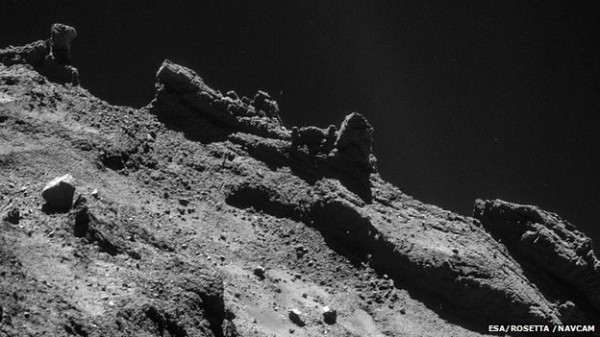November 20, 2014 – In the 60 hours before the batteries drained the Philae lander on Comet 67P/Churyumov-Gerasimenko looked around and using the Cometary Sampling and Composition Experiment (COSAC) on board the lander detected carbon molecules.
From its slightly skewed landing Philae’s Navcam took some pictures. One seen below shows a thin layer of regolith covering ice underneath. This ice was found to have the consistency and strength of sandstone partly because it is an ice-regolith slurry and because of low temperature at the comet surface.
The scientists even got Philae to deploy its sampling drill and were able to extend it to its full extent and then bring it back up. Preliminary results indicate the comet has a very porous interior with a hard icy and dusty outer layer, 10 to 20 centimeters (4 to 8 inches) thick.
With its battery drained Philae is asleep now but the initial 60 hours of readings, still being analyzed by the European Space Agency team, should reveal more about the extent and nature of the comet and the organic molecules found there.
For cosmologists the finding of carbon and organic compounds is an affirmation of a theory that the elements of life can be found in abundance throughout the Universe and have been a part of the Solar System since its formation over 5 billion years ago. That theory, panspermia, was first proposed by a Greek philosopher, Anaxagoras, in the 5th century BCE. It reemerged in the 18th century when a natural historian, Benoit de Maillet, described the seeding of Earth from space leading to life.
Lord Kelvin, William Thomson, one of the 19th century’s prominent physicists and engineer, was a proponent of panspermia although a critic of Darwin’s theory of evolution. Kelvin was convinced that the Solar System was a mere 40 million years in age, and, therefore, Darwin’s natural selection, requiring a much greater amount of time to explain the evolution of species, couldn’t be right.
In 1871, however, Kelvin wrote “we must regard it as probable ….that there are countless seed-bearing meteoric stones moving through space…..one such stone falling upon [Earth] might by what we blindly call natural causes, lead to its becoming covered with vegetation.”
Fred Hoyle, the famous British cosmologist of the 20th century and author of the discredited steady state theory of the Universe, revived panspermia. But most scientists disagreed with his hypothesis. And then a meteorite found in Antarctica back in 1984 and analyzed in 1996, believed to have originated from Mars, was found to contain microscopic evidence of nanobacteria. Although controversial (was this life or a chemical reaction within the rock) the finding put more credence to the viability of panspermia. A lesser known discovery in 2001 by molecular biologists from the University of Naples found evidence of alien bacteria deep inside a meteorite determined to be 4.5 billion years in age. The DNA although similar to some modern bacillus bacteria was not a match for anything found to date on this planet. Even Stephen Hawking has speculated that in venturing into space we will find DNA adrift or coating the surface of primordial bodies like comets and asteroids. That will be humanity’s close encounter.
So with Philae finding carbon and other organic compounds on Comet 67P/Churyumov-Gerasimenko, it is affirming that panspermia may very well be the explanation for how life spread from space to Earth through the encounter of our planet with a comet, asteroid or meteorite.













